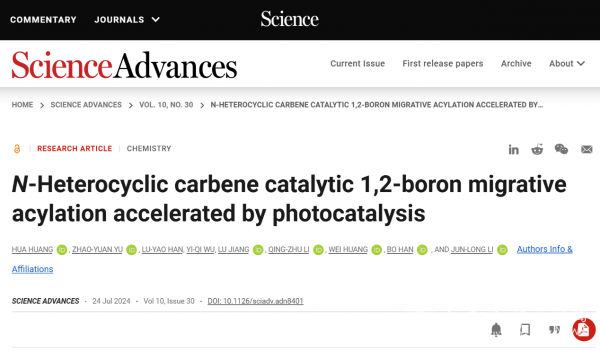On July 25 at 2:00 a.m. (Beijing time), Science Advances ( Nature Index and the Chinese Academy of Sciences Tier I and Top Journal), a journal affiliated with Science (an international authoritative academic journal), published online the latest findings of the chiral and biomimetic synthesis research team from Chengdu University, titled "N-Heterocyclic carbene catalytic 1,2-boron migrative acylation accelerated by photocatalysis". Huang Hua, a graduate student enrolled in 2021 jointly trained by the School of Pharmacy, is the first author, and Professor Li Junlong is the corresponding author.

Professor Li Junlong's team at the School of Pharmacy has long been committed to the cutting-edge investigation of nitrogen heterocyclic carbenes (NHCs) as organic small molecule catalysts in drug synthesis. In this work, the team reported for the first time a photo/NHC synergistic catalysis that successfully achieved migrative acylation of the C─B bond via the radical-induced 1,2-boron migration. The research involved the use of a newly developed β-boronic ester substrate, which, through single-electron reduction in the carbene catalytic system, produced key β-boron radical intermediates. These intermediates underwent 1,2-boron migration and ultimately formed a series of β-acyl boron compounds through a radical coupling pathway.

This catalytic strategy is well-suited for post-structural modifications of drug molecules and physiologically active compounds, including non-steroidal anti-inflammatory drugs such as diflunisal, tolmetin, naproxen, and isoxepac, lipid-lowering agents such as ciprofibrate, and other naturally pharmacologically active products such as geraniol and zingerone. Finally, the team further performed a series of mechanistic experiments and density functional theory (DFT) calculations to elucidate the nature of this reaction.

This research work received strong support from various funding sources, including the National Natural Science Foundation of China, the Innovation Research Group of Sichuan Provincial Natural Science Foundation, the Longquan Talent Program, and the Guangdong Key Research and Development Program.
Science Advances is a journal included in the Nature Index and the Chinese Academy of Sciences Tier I and Top Journals. It is an affiliate journal of Science, a leading international scientific journal, and is published by the American Association for the Advancement of Science (AAAS), one of the largest and oldest comprehensive scientific organizations in the world, with a current impact factor of 11.7. It is a world-class, top-tier, comprehensive academic journal covering various academic fields such as chemistry, life science, physical science, engineering, environmental science, materials science, and medicine, enjoying a high level of academic recognition across all these fields.